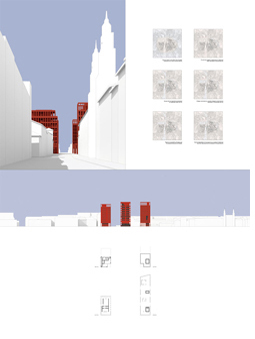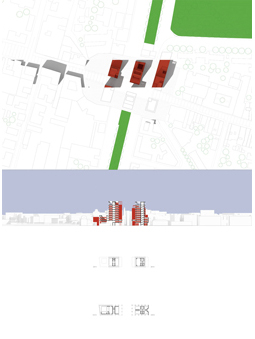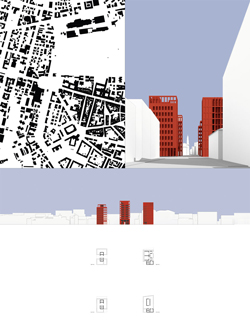You are in: Home page > IP Workshop - Compact City Architecture > BLOND TEAM
IP Workshop - Compact City Architecture






BLOND TEAM






PIAZZALE SANTA CROCE, PARMA
Piazzale Santa Croce, Parma. Analysis and Design.
Point of departure and premise of the design is an analysis of the spatiality of the place. It aims toward the design and is restricted to phenomenolo-gical aspects. Spatial phenomena are subjected to an interpretation which attempts to elucidate the preexistent – always with reference to their significance for the design: the object of the analysis is the town, the design of the town. The analysis searches for references for spatial interventions, for necessities and possibilities, for boundaries and transitions; it aims toward the design, and poses a question. The design is understood as a hypothesis that is exami-ned at a specific place exemplary for other places in the town. While the design strives for generalizability, the analysis seeks to establish a rule.
Town and Country. The inner spatiality of the historic town and the external spatiality of the landscape.
The town wall defines the historic town of Parma as an “inside,” and the surrounding landscape as an “outside.” The “inside” of the town is further differentiated by the insertion of the “outside” of the landscape: on the one hand, the linear form of the ri-ver divides the town of Parma into two halves; on the other, the expanse of the Parco Ducale transports the breadth of the landscape into the town. Where the architectural corpus of the town is penetrated by exterior landscape spaces, the question is posed of the continuity of “inner” spatiality. [fig. I]
Town. The spatiality of the contemporary town and the inner external space of the landscape.
The growth of the town and the demolition of the town wall left behind an “inner” shell which imprints the wall’s original contours: the original delimiting form becomes a space that is endowed with landscape character: “external” space set within the town’s “interior”. [fig. II]
Boundary. Interiors of the town and exterior spaces of the landscape. Interpenetrations of ”inner” and “outer” spaces appear at various situations in the form of historically evolved locations which provide no answer to the question of the convergen-ce of town and landscape, and which fail to respond adequately to aesthetic challenges. Evident where streets lead out of the town is the ambiguity of a planless convergence of the inner spaces of the town with the outer spaces of the landscape. [fig. III]
Transition. Inner spatial affiliations within the town.
The design strives first for continuity between the “inner” spaces of the town, and secondly to redefine the relationship between its “inner” spaces and the “outer” ones lying beyond. Along points of con-vergence between “inner” and “outer” spaces, the intervention allows spaces to emerge that are expli-citly interrelated and which deal with to the divergent scales of town and landscape in a fitting way. [fig. IV]
The Design .The Plazas and streets of the town.
The Piazzale Santa Croce appears as an urban field where the “inner” spaces of the town and the “outer” spaces of the landscape converge while failing to relate to one another successfully. Six buildings are positioned on the excessively broad Piazzale to form a rectangular plaza. The “outer” spaces of the landscape within the town are enclosed unambi-guously; the Via Emilia presents itself here as both street and plaza, as a rhythmic, linear sequence of spaces that is articulated by the rectangular entran-ces of plazas, streets, and alleys. The buildings insert themselves in an individual and organismic way; through their height, they respond to the various scales of town and landscape. Drawing upon the spatial vocabulary of Parma (plaza, street), the design founds a new order, that presents itself through an explicit geometry while at the same time aligning itself with the existence urban fabric. Two urban districts which were separated by historic, but meanwhile superseded facts are linked via a rhythm of spaces. Exemplary and prototypical, the design demonstrates possible solutions for this and other places within the town of Parma where “inner” and “outer” have not yet aggregated to form a whole.

















